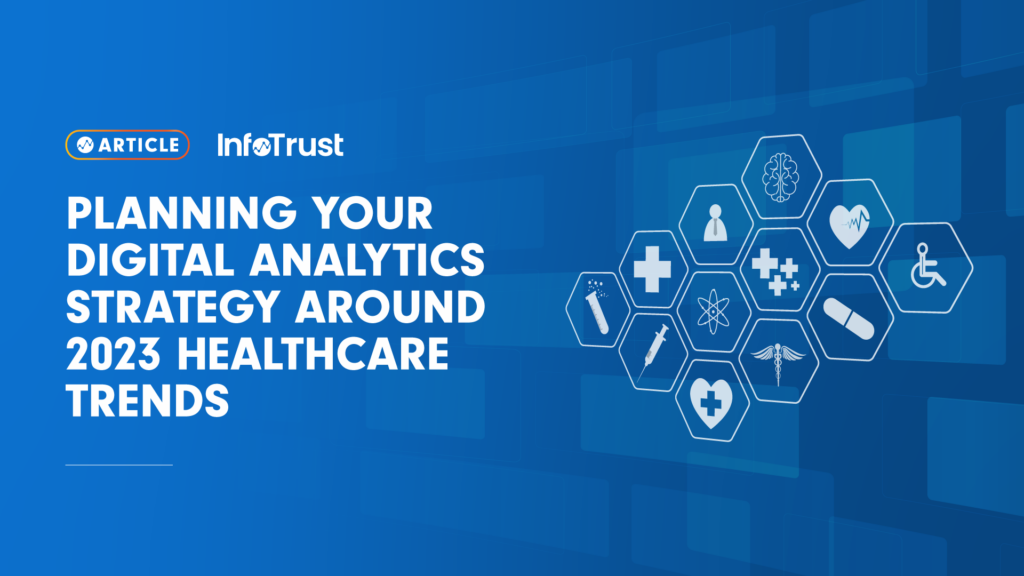The weather is cooling. Leaves are falling. You see your first Christmas display at your local home goods store. Mariah Carey starts playing on every radio station (you know the song). These are just a few signs you’re on the last leg of 2022 and heading into the new year!
So what lessons did you learn in 2022, and how is your healthcare organization starting to plan for 2023? As the Industry Team Lead for our Healthcare and Fitness team at InfoTrust, we speak with healthcare organizations every week, and follow industry trends like it’s our job (literally… it’s our job!). We then break down those trends to help understand how they can be measured and optimized, with an emphasis on web analytics and data governance.
2023 will surely bring us some unexpected surprises, but there are a handful of trends whose impact seems inevitable, which I’ve outlined below:
Patient Engagement with Online Portals
Online patient portals are becoming more common and more convenient for patients; specifically no more waiting on hold on the phone! They also help decrease administrative costs and frustration for office staff. Patients can message their doctor without an appointment, refill a subscription, or even set up an appointment—all in one easy, secure, and private interface.
This additional online engagement should be measured and analyzed within Google Analytics. How easily are users able to navigate to the most frequently visited pages of your portal? Have you configured a conversion event around all core KPIs? Are you tracking logged in vs logged out users as a custom dimension? Have you implemented user ID for cross-device analysis and to help pair your analytics data with user data in your CRM (Customer Relationship Management) platform? This data can not only help you measure the success of your patient portals, but also optimize the portal for an improved user experience.
Telehealth and Telemedicine
The pandemic in 2020 caused many healthcare providers to embrace telehealth to help reduce the in-person transmission of COVID-19. Many patients understandably feared spending time in waiting rooms, or catching the virus from reception assistants, nurses, and doctors. Whether we like it or not, doctors offices and hospitals are full of germs, and often some of the more routine healthcare checkups don’t require in-person interactions. 2020 allowed healthcare organizations to experiment with the concept of telehealth and telemedicine, and many of its advantages have continued into 2022 and should continue to grow into 2023.
This opportunity is important to measure for digital analysts and marketers. Are you recording appointment sign-ups with a Google Analytics 4 conversion event? Are you using UTM parameters in your text and email reminder links to measure clickthrough rates? Are you capturing data on users modifying or canceling appointments? The more digital healthcare becomes, the more opportunities we have to measure success and identify areas of improvement.
Outsourced Billing, Expensive Tech, and Security Costs
The healthcare industry is experiencing staffing shortages, causing medical organizations to scramble to complete billing paperwork—in some cases, even outsourcing the practice to dedicated medical billing facilities. While that’s a suitable approach for some, you’ll want to ensure that all cloud computing is closely integrated with your CRM and CDP (Customer Data Platform). Accuracy in your CRMs and CDPs is a substantial part of your first-party data strategy and can help feed email campaigns and retargeting ad campaigns.
In addition to staffing shortages causing headaches, healthcare software and the required technology to protect it is not cheap. Sensitive healthcare data is sought after by criminal hackers, so security should always be at the forefront of your decision making. Some media pixels may not be as safe or secure as you think, and implementing them through your TMS or hardcoded on your page source may have unintended consequences. Tag Inspector can let you know if any additional technologies are piggybacking off the original tag you deployed on your site—thus collecting data you and your patients have not consented to.
Remote Patient Monitoring and Home-Based Care
Modern healthcare technology allows healthcare organizations to monitor patients remotely (e.g. heart monitors), allowing in-home study instead of keeping patients hospitalized for longer than necessary. That technology can provide vital statistics to healthcare workers while patients can live in the convenience of their home or even continue to work remotely while being monitored.
Of course, there are some disadvantages: older patients may become socially isolated, or smaller homes/apartments may not have the space to safely store medical equipment and supplies. But on a case-by-case basis, we expect to continue to see more and more remote patient monitoring in 2023 due to the cost-saving and convenience it provides. The data you’re collecting in this case should not be stored in Google Analytics (no Personally Identifiable Information!), but collecting data on how users are engaging with online portals during their home-based occupancy will still provide insightful data.
Conclusion
There will always be unknowns in any industry and healthcare is no exception. However, hopefully you agree with some of our predictions. What trends did I miss? How is your organization adapting to change and preparing for 2023? Don’t hesitate to reach out to InfoTrust to determine how we can help you achieve your web analytics and data governance goals in the new year.


